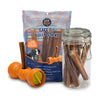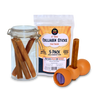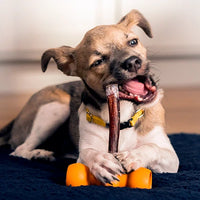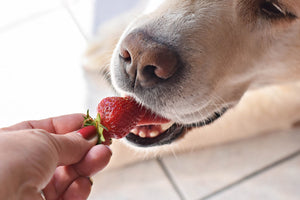Summer is a time for sunshine, fun and making memories—but just because the sun is shining and the smiles are plentiful doesn’t mean it’s all smooth sailing. In fact, this season can bring a handful of hidden risks, especially for our fur-covered companions.
Here are some of the most overlooked summertime habits that can become hazardous for dogs—and things you can do to keep your pup safe, happy and healthy.
1. Hot Pavement and Walk Timing
Daily walks are essential. They get your dog’s body moving, help circulate synovial fluid around the joints, provide sensory stimulation and support the basic need for movement. But summer changes the rules. That same healthy habit can turn dangerous fast when the pavement heats up.
Did you know that asphalt and concrete can reach temperatures over 120 degrees? Even if the air temp feels fine, these surfaces have been absorbing heat throughout the day and can get hot! A good rule of thumb? Press the back of your hand to the pavement for 7 seconds. If you feel it’s too warm for you, it is definitely too hot for your dog’s paws to walk on.
Safe solution: Walk your dog early in the morning or after the sun goes down. Not only are these cooler times of day easier on your dog’s body, but early morning light exposure (without sunglasses or sunscreen for about 10 minutes) has actually been shown to help you regulate your circadian rhythm, improve melatonin production and support better sleep. 1
So yes—you’re both getting your steps and potentially sleeping better. Win-win.
And if your schedule doesn’t allow for those dawn or dusk walks? Keep it short. Let your dog go potty, hydrate and then head back indoors to a cooler environment. (P.S. Stay tuned—our next blog will give you creative indoor activities to help tire out your pup when outdoor play isn't an option.)

2. Dehydration and Overheating
Dogs are far less efficient at cooling down than you may think. This is because they do not sweat like we do, and their body temperature regulation is primarily accomplished through panting. So while you don your shorts and tee, remember, your dog is still in fur from snout to tail!
Signs of dehydration or heat stress can include:
- Excessive panting
- Thick, ropey saliva
- Lethargy
- Glazed eyes
- Vomiting or collapse (in extreme cases)
What to do: Always bring fresh water on walks or outings, and take frequent breaks in the shade. It’s also best to avoid walking between 10 am to 4 pm whenever possible as this is when temps are usually at their highest.

3. Pool Time Still Requires Supervision
If your dog loves to swim, that’s amazing! Swimming is a fantastic low-impact exercise and great for dogs with joint issues. But don’t fall into the trap of thinking all dogs are natural swimmers or that they’ll know when to stop. Just like kids, dogs often don’t realize when they’re overdoing it.
Here’s how to keep it safe:
- Always supervise your dog around water—even if they’re experienced swimmers.
- Install an easy-access ramp or steps so they can get in and out without panicking.
- A dog-specific life vest is never a bad idea, especially for deep water or boating.
- Provide fresh, non-chlorinated water by the pool. Dogs may drink chlorinated pool water, which isn’t ideal.
- When your dog is done for the day, be sure to rinse them off with clean water to remove chlorine or salt that can dry out their skin and coat.
This advice also applies to all you boaters—saltwater can wreak just as much havoc on skin and fur as pool chemicals.
4. Lazy Days in the Sun Can Still Be Risky
If your dog prefers to lounge outdoors in the heat, they’re not alone, but that doesn’t mean it’s automatically safe. Even in the shade, heat can accumulate quickly, and your dog might not recognize when they’re pushing their limits.
Make sure to:
- Provide ample shade
- Offer fresh, cool water
- Limit time spent in intense heat
- Use your judgment! You know your dog best—and just like toddlers, dogs may not stop playing even when they’re tired or overheated.
Final Thoughts: Hydration Is Key
No matter where your summer adventures take you—on foot, by pool or off to the beach— always bring water and offer it to your dog frequently. Hydration is incrediblyimportant.
Summer is a great time to get outdoors and spend quality time with your dog. Remembering these simple precautions will help ensure that you get to enjoy every moment together safely. Now go have fun!
Johnna Devereaux is a Clinical Pet Nutritionist, canine wellness expert and Chief Nutrition Officer for Bow Wow Labs.
* This article is for informational purposes only. It is not, nor is it intended to be, a substitute for professional medical or veterinary advice, diagnosis, or treatment and should never be relied upon or perceived as specific medical or veterinary advice.
**The points of view expressed above are those of our clinical nutritionist and are supported by science, her education and experience. We are committed to providing the best, most straightforward, and most helpful information possible to help keep your dog happy, healthy and safe.

















